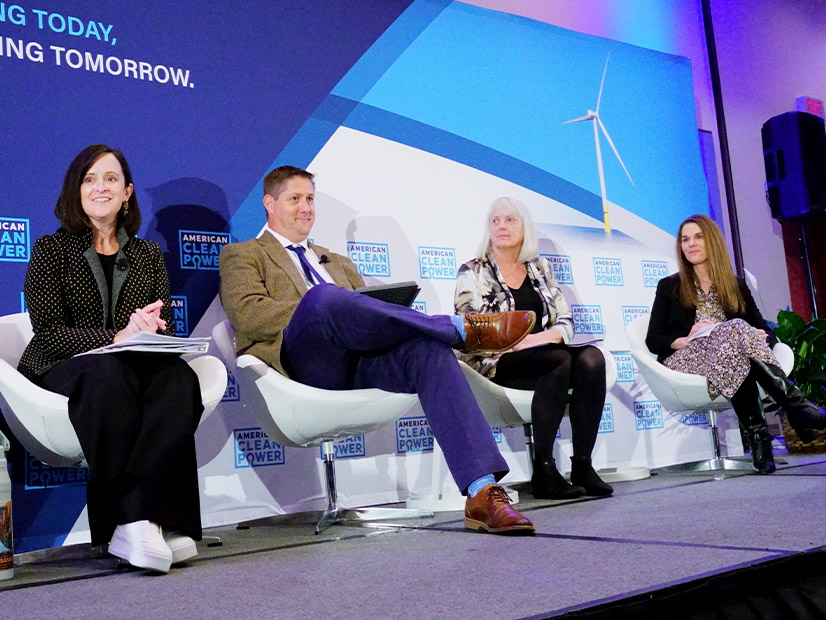
ATLANTIC CITY, N.J. — The Bureau of Ocean Energy Management has decreased its offshore wind permitting times 20% as it gains experience and works to expedite development of the clean energy sector.
BOEM Director Elizabeth Klein shared the news as she joined other federal regulators and a manager at a leading offshore wind developer for a discussion on lessons learned from early U.S. offshore wind projects.
There has been a lot to learn, certainly, as well as ample opportunity to learn from setbacks as the industry tries to gain traction in the United States.
“We’ve examined our permitting processes because we want to make sure that we are being as efficient as possible while also creating durable decisions,” she said Oct. 29 at Offshore WINDPOWER 2024.
The most recent of these updates were announced the same day Klein spoke: BOEM debuted its new POWERON acoustic monitoring program to protect biodiversity in offshore wind lease areas, and it signed a memorandum with the Department of Defense to collaborate on their reviews of development proposals.
“There is just an incredible amount of effort, there’s an incredible amount of work that I think we can all be very proud of,” she said.
The Biden administration this year rebranded the Federal Permitting Improvement Steering Council as the Permitting Council. Executive Director Eric Beightel said it has sought to improve communication and understanding across the many federal agencies involved in offshore wind permitting and avert potential conflicts among a diverse set of core missions.
“I think that that is a very powerful tool that is underutilized in government, and that we’re anxious to do more of it,” he said. “At the end of the day, the goal for me is to work ourselves out of a job — that we’ve instituted these sorts of best practices, these open lines of communication in such a way that it just becomes more normal.”
Janet Coit, assistant administrator for NOAA Fisheries, said her agency has been involved in marine mammal protection work for all 10 of the federally authorized offshore wind projects to date.
“Many of the folks who work at NOAA Fisheries were an office of one or two people, and we’ve also — as well as the industry — had to staff up, had to look for ways of providing more specific and clear guidance, and learned a lot along the way,” she said.
Protection of marine mammals, especially whales, is a key target for offshore wind foes, so it is critical to produce science-based decisions that will withstand litigation, Coit said.
The most prolific U.S. offshore wind developer, Ørsted, has encountered many teaching moments as it put steel in the water.
“Spoiler alert: Things don’t always go as planned when you hit the field, when you hit the water,” said Patty DiOrio, who leads the Danish company’s North American offshore project development team. “So I’ll be talking about some lessons learned. … We’re getting better and better with every position that we install.”
Some highlights from the four speakers:
-
- Little things like making sure agencies are talking to the right people at other agencies sound simple but do not always happen. — Klein
-
- Making the Notice of Intent checklist and FAST-41 processes work in concert is important, and getting the Permitting Council involved in the process early makes it more effective. — Beightel
-
- Having a large enough staff and budget is critical. — Klein
-
- Clarity, predictability and consistency by regulators are all good, but flexibility is critical, because weather, supply chain hiccups and other factors can change the best-laid plans. — DiOrio
-
- Good communication allows problems to be addressed early, before they fester. — Beightel
-
- Timely onshore grid upgrades are a priority, because they represent an unknown cost factor for developers. — DiOrio
-
- Mitigation of effects on fisheries should be thought out regionally rather than project by project. — Coit
-
- The Permitting Council is investing millions in artificial intelligence technology to speed administrative review of comments and documents so staff can concentrate on the necessary analytic work. — Beightel
-
- NOAA Fisheries is hiring people to meet a recommendation by developers to have dedicated project coordinators. — Coit
DiOrio seconded this last point: “You cannot overstate how key they are. They really just keep the gears in motion, and it makes a huge, huge difference.”
Panel moderator Ted Boling, a partner at law firm Perkins Coie, asked DiOrio if she thought the federal government is responsive.
“Do you see your lived experience with installation being reflected in the way federal agencies are approaching mitigation, monitoring, the plan of operation?” he asked.
“I think we’re getting there. I really do. We’ve gotten good collaboration when things happen,” she responded.
Boling lobbed an audience question at Klein: “There is a phrase, ‘Don’t let the perfect be the enemy of the good.’ It can feel like that standard of approval is perfection. Can we move to good enough?”
Klein recalled another regulatory learning curve, when early large-scale solar energy projects were proposed in the United States.
“You know, at the beginning, everything can feel new, and it’s like every single environmental review is really difficult and eventually you get to a point where you can benefit from efficiencies, you can use existing environmental documents.”
But now is not the time to cut corners and risk a setback through opponents’ litigation, she said.
“The hope is always that this will become more routine, and it won’t feel so hard to get every single project review across the finish line, because there will be standardization across the industry in some aspects, and it will feel less difficult.”


